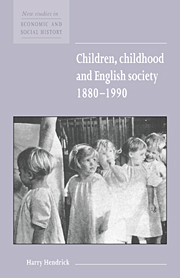Book contents
- Frontmatter
- Contents
- Acknowledgements
- 1 Introduction
- 2 New ideas of childhood: the 1880s to the 1920s
- 3 Parent–child relationships
- 4 Children and social policies
- 5 Children, schooling and the classroom
- 6 Children's leisure
- 7 Conclusion: disappearing childhood and children's rights
- Bibliography
- Index
- Titles available in the New Studies in Economic and Social History series
- Titles available in the Studies in Economic and Social History series
- Economic History Society
4 - Children and social policies
Published online by Cambridge University Press: 05 June 2012
- Frontmatter
- Contents
- Acknowledgements
- 1 Introduction
- 2 New ideas of childhood: the 1880s to the 1920s
- 3 Parent–child relationships
- 4 Children and social policies
- 5 Children, schooling and the classroom
- 6 Children's leisure
- 7 Conclusion: disappearing childhood and children's rights
- Bibliography
- Index
- Titles available in the New Studies in Economic and Social History series
- Titles available in the Studies in Economic and Social History series
- Economic History Society
Summary
Until recently historical studies of child health and welfare assumed a ‘Whiggish’ tone, that is, they usually saw legislative developments in terms of ‘progress’ – a continually improving position [23; 24]. (But not all scholars subscribed to this view [87] and, unsurprisingly, political histories of welfare offered more searching examinations [88].) Older histories, along with several current standard textbooks on social policy, tend to describe the gathering pace of the legislation in terms of what Jean Heywood calls ‘the growth of state obligation towards the child’ [24: 94; also 89–91]. Since the late 1970s, however, a new and more critical history has appeared, often influenced by Marxism, liberal radicalism, Foucauldian perspectives and, to a lesser extent, feminism [11; 14; 16–18; 26; 27; 32; 55; 92–7]. Most of these modern views, while not denying either a degree of legislative progress or the increasing role of the state, propose a more complex and varied set of causes and consequences, seeking as they do to be more precise and more analytical in their accounts.
Approaches
In order to illustrate the variety of ‘overarching’ understandings of child welfare, this section selects several approaches adopted by different scholars.
In pursuit of a broader conceptual framework, it has been tentatively suggested that the history of child welfare might be usefully examined through, on the one hand, two ‘dualisms’: bodies/minds and victims/threats and, on the other, through the notion of children as investments [59].
- Type
- Chapter
- Information
- Children, Childhood and English Society, 1880–1990 , pp. 36 - 62Publisher: Cambridge University PressPrint publication year: 1997



